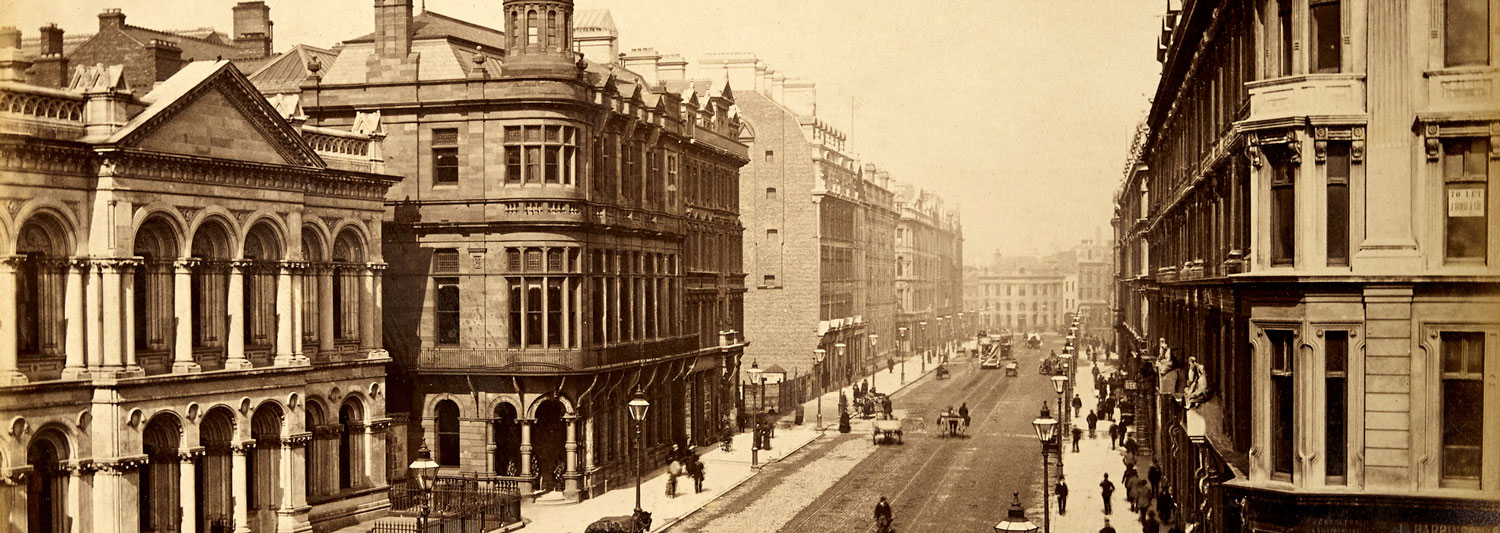As a social historian and a teacher of A level history, I am sometimes dismayed by how little social history there is on the A level history syllabus. My own academic research and publications focus on the social history of nineteenth century Ireland – and while I don’t necessarily expect to teach about middle-class life in Victorian Belfast (the subject of my book), it would be nice to cover at least a bit of Irish social history. Apparently, several decades ago, Victorian Belfast was on the A level curriculum in Northern Ireland. I really hope that’s not an urban myth. Now, I suspect, to put it on the specification would be seen as too dangerously divergent from what other exam boards are doing.

[Castle Place Belfast 1880-1890 Lawrence Photograph Collection NLI L_CAB_04198]
Even a degree of Irish social history would be nice, but there is basically none. Instead, at A2 the vast majority of students study the Irish Revolution/ Partition of Ireland 1912-22 – and besides a brief reference to the cultural nationalism of the Gaelic Revival – it’s a narrow political focus. Maybe it’s just me, or the decade of centenaries now nearing an end, but the Irish Revolution of the early twentieth century seems to be done to death and is wearing thin. It would be great to teach, for example, the industrial revolution and how it affected Britain and Ireland both socially and economically – bringing in a bit of local history that students can relate to.
I prefer the topics I teach at AS (and I suspect the students do too). At AS level we do Weimar and Nazi Germany (1914-45) and Russia (1914-53), encompassing the Russian Revolutions and Russia under Lenin and Stalin. Again, both the German and Russian units heavily prioritise political and economic history, with the social history of these turbulent and fascinating years relegated to a small fraction of the course. Indeed, in recent years, the economic history element has been increased, and the social history component reduced. So the interesting stuff on young people and women in Nazi Germany has now been replaced by the Total War Economy. Economic history is challenging for students. While I have to admit that I rather enjoy trying to find new and inventive ways to explain the 1923 hyper-inflation crisis every year to fresh 16 year olds who have barely begun their A level studies, they may find the experience rather more daunting. (It’s worth remembering that we history teachers, and our students, have to master complicated economic and political concepts and theories as a matter of course as we go along – while other A levels are entirely devoted to them).

[Lenin, Trotsky and Kamenev celebrating the second anniversary of the October Revolution By L.Y. Leonidov – Public Domain]
AS history students, many of whom have already covered Nazi Germany at GCSE, usually relish the opportunity of studying twentieth-century Russian history. It’s new, it’s exciting, it’s dramatic: it’s full of wars and revolutions. What’s not to like? While the exam questions may focus on Lenin and Stalin’s economic policies, when teaching the course it’s natural and easy to incorporate the teaching of social history. Indeed, given the dramatic social consequences of the economic policies of communism, it would be hard not to.
So, over the next few weeks I intend to devote a good chunk of class time to teaching my students about culture and propaganda under Lenin and Stalin, and how society and culture underwent massive upheaval in the 1920s and 1930s. It won’t be on the exam, but then, exams are cancelled this year anyway.
Dr Alice Johnson
- Middle Class Life In Victorian Belfast, with Alice Johnson at the Linenhall Library (on YouTube)
- Liverpool University Blog: Middle-class life in Victorian Belfast in conversation with Alice Johnson

